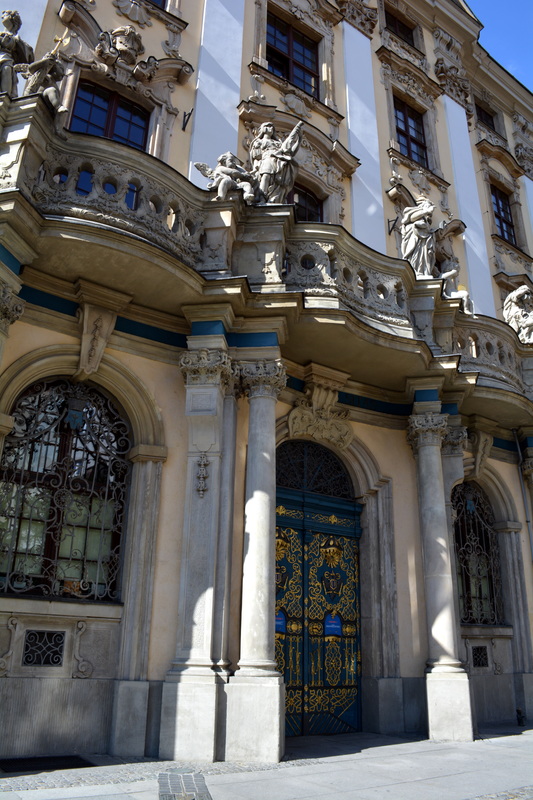Seeing Historic Wroclaw by
Horse and Carriage
One of the most relaxing ways to tour historic Wroclaw Poland is by horse-carriage. We caught up with a carriage in the market square and hopped on board for a tour of the old-town, past the beautiful Baroque, Wroclaw University established in 1702, and across the River Odra to Piasek Island and Ostrow Tumski all the while, taking in the many impressive cathedrals and churches which dot the historic center of the old city.
Wroclaw which was founded in the by a Czech duke in the 10th century has been influenced by several European cultures. The village became a Polish bishopric in the year 1000, and was later was designated as the capital of the duchy of the Silesian Piasts. Eventually it came again under Czech rule in 1335. In 1526, it was made part of the Hapsburg Empire and by 1741 was under Prussian rule. These various cultures left their mark on the fabulous architecture and art of the city through which we made our relaxing tour.
Wroclaw which was founded in the by a Czech duke in the 10th century has been influenced by several European cultures. The village became a Polish bishopric in the year 1000, and was later was designated as the capital of the duchy of the Silesian Piasts. Eventually it came again under Czech rule in 1335. In 1526, it was made part of the Hapsburg Empire and by 1741 was under Prussian rule. These various cultures left their mark on the fabulous architecture and art of the city through which we made our relaxing tour.
Below: The University of Wroclaw - Established in 1702 by Emperor Leopold I
Below: Church of the Holy Name of Jesus - Built for the Jesuits in 1689-98. Silesian Baroque Architecture.
The Ossolineum was founded in 1817 by Józef Maksymilian Ossoliński, politician, writer and researcher who devoted his life to building and cataloguing an extremely rich library collection, the second in the country when it comes to size after the Jagiellonian Library of Kraków. It has become one of the most important research centers on scientific, historic and Polish literature. It contains one of the largest book collections in Poland as well as a large collection of manuscripts and autographs including medieval manuscripts and some of the oldest prints in Poland.
Piasek Island (Sand Island) has been a religious center and the location for a Canonical Monastery since the first half of the 12th century.
Below: Church of St. Mary on Piasek - the 14th century church is built on the site of a 12th century Romanesque building whose tympanum is built into the wall over the sacristy in the south aisle.
Ostrow Tumski (Cathedral Island)
The history of Wroclaw began on Ostrow Tumski and was once an island in the River Odra. According to legend, the city was founded by in the 10th century by Duke Vratislav of Bohemia. Over time, the island grew into a center of ducal power. It moved to the left bank in 1292, where the current city of Wroclaw grew. In the 19th century, the northern arm of the Odra was filled in and Tumski ceased to be an island.
Ostrow Tumski is a lovely place to visit and has a number of interesting sites. It remains the location of the Archbishop's Palace.
The history of Wroclaw began on Ostrow Tumski and was once an island in the River Odra. According to legend, the city was founded by in the 10th century by Duke Vratislav of Bohemia. Over time, the island grew into a center of ducal power. It moved to the left bank in 1292, where the current city of Wroclaw grew. In the 19th century, the northern arm of the Odra was filled in and Tumski ceased to be an island.
Ostrow Tumski is a lovely place to visit and has a number of interesting sites. It remains the location of the Archbishop's Palace.
Below: Church of the Holy Cross built between 1288-1484
Ulica Katedraina and the Cathedral of St. John the Baptist built in 13th - 14th centuries
Below: Church of St. Giles built in the 1230's
Below: Ostrow Tumski - Botanical Gardens of the University of Wroclaw
Below: Sisters of St. Elizabeth Monastery
Below: National Museum of Wroclaw
Below: Galleria Awangarda - Wrocław's most cutting-edge art museum, Awangarda is located within the old Hatzfeld Palace. Destroyed during World War II, this 'living ruin' was adapted into an art space and now runs exhibitions that comment on current social and political issues
Back at the Market Square! What a wonderful way to see the historic city of Wroclaw.













































